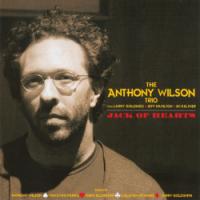Turns Your Turntable Into a Ticki-Bar!
While two of the three previous jazz records guitarist/arranger Anthony Wilson made with producer Joe Harley were guitar/drum/organ sessions, this one also featuring those instruments is much different.
Though it’s definitely a jazz album, the inclusion of legendary rock drummer Jim Keltner instead of a more swinging, lighter touched jazz percussionist gives Jack of Hearts a much different anchor and a mostly retro-feel. The experiment is never less than interesting and often great, but it doesn’t always work as well as intended.
While two of the three previous jazz records guitarist/arranger Anthony Wilson made with producer Joe Harley were guitar/drum/organ sessions, this one also featuring those instruments is much different.
Though it’s definitely a jazz album, the inclusion of legendary rock drummer Jim Keltner instead of a more swinging, lighter touched jazz percussionist gives Jack of Hearts a much different anchor and a mostly retro-feel. The experiment is never less than interesting and often great, but it doesn’t always work as well as intended.
Keltner’s insistent drumming puts organist Larry Goldings in an equally steady groove and allows Wilson to play blockier and more aggressively than on previous albums.
The opener, the Wilson/Goldings original “Mezcal,” with its slinky retro two-chord vamp, will turn your turntable (or SACD/CD player) into a ticki bar. Everyone’s playing on the simple side, with Goldings repeating an almost mindlessly simple organ riff that’s as funny as it is contagious. Wilson underplays behind before breaking into an angular, latin-ish riff. The repetition will pleasantly break down even the most snobby jazz aficionado.
The sly title track written by Wilson comes next. It opens sounding like something from the Henry Mancini/Pink Panther playbook. Keltner plays jazz-like, but with an insistence that weighs the piece into a really deep groove where both Goldings and Wilson can dig down to produce a bluesy pop-like swagger that will have your head nodding at the cool.
Coleman Hawkins’s “Hawkeyes” never really gets off the ground for me but with players of this caliber there’s always something of interest. Duke Ellington’s “Carnegie Blues,” which obviously inspired Neal Hefti’s “Lil’ Darlin,’” gets back to the deep groove, while the unusual choice to cover Jerry Goldsmith’s “Theme From ‘Chinatown’” works beautifully with Wilson, after a Chinese scale intrigue minute or so opening, gliding gracefully along the melody lines trailed by Goldings' fills and Keltner’s explosive kick drum accents.
There’s a slow, deliberate cover of Van Dyke Parks’ “Orange Crate Art” that works nicely, with Wilson laying out the melody on hollow bodied electric and Goldings adding a funk that moves the song from Los Angeles disappeared orange groves to something out of New Orleans.
Wilson and Goldings contribute “Harajuku” another catchy number that’s more Roscoe’s Chicken and Waffles than Trader Vic’s but just as retro and just as tasty.
Wilson ends the set with his “Homecoming” in which Keltner could just as well have played twice as fast and then have the tape slowed down, for all the weight and bottom end he producesbut not before “Zweet Zursday,” another irresistible Duke cover.
Jazz purists might wonder about the choice of Keltner, who even when playing jazzy rhythms, is unmistakably a rock drummer by temperament and touch. Not being said purist, I think the choice was inspired. Even when on occasion you might be wishing for a slightly lighter, breezier touch, Keltner makes it interesting.
Sonically, you get everything you could hope for in a Michael C. Ross Oceanway live to two track analog production. There are sonic riches galore from the to-salivate-from Hammond B-3 organ with its big, fat warm bass lines to the warm, round yet precise electric guitar lines and the woody, cracklin’ rim shots snappy snares, punchy cymbals and cataclysmic kick drum explosions. Ross is going for impact not soundstaging or three guys playing in the distance in a big room, so expect a big drum kit spread across the stage and room-filling man-sized images.
So crank it up and enjoy this not-so-guilty, below the neck retro-pleasure fest. Yes the CD layer sounds pretty good and the SACD even better, particularly in the air and atmosphere department but for the full effect, do insist upon the double 45 rpm version. It’s the biggest and the best bang for your (extra few) bucks!
- Log in or register to post comments




